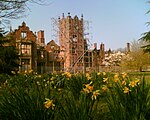Boat Yard Crossing Halt railway station
1912 establishments in England1930 disestablishments in EnglandClosed railway lines in EnglandDisused railway stations in LancashireFormer Lancashire and Yorkshire Railway stations ... and 4 more
Pages with no open date in Infobox stationRailway stations in Great Britain closed in 1913Railway stations in Great Britain opened in 1912Use British English from March 2015
Boat Yard Crossing Halt railway station was a short-lived station on the Tarleton Branch. It was situated near the River Asland and served as the only intermediate station on the line. The site has long since been demolished and is now occupied by a housing estate.
Excerpt from the Wikipedia article Boat Yard Crossing Halt railway station (License: CC BY-SA 3.0, Authors).Boat Yard Crossing Halt railway station
Merlecrest Drive, West Lancashire Tarleton
Geographical coordinates (GPS) Address Nearby Places Show on map
Geographical coordinates (GPS)
| Latitude | Longitude |
|---|---|
| N 53.6884 ° | E -2.8282 ° |
Address
Merlecrest Drive
Merlecrest Drive
PR4 6BD West Lancashire, Tarleton
England, United Kingdom
Open on Google Maps







